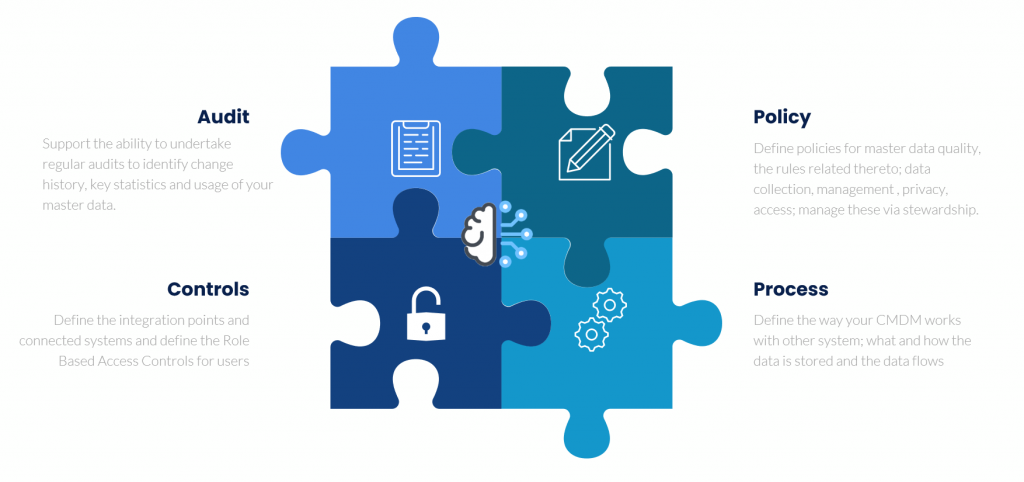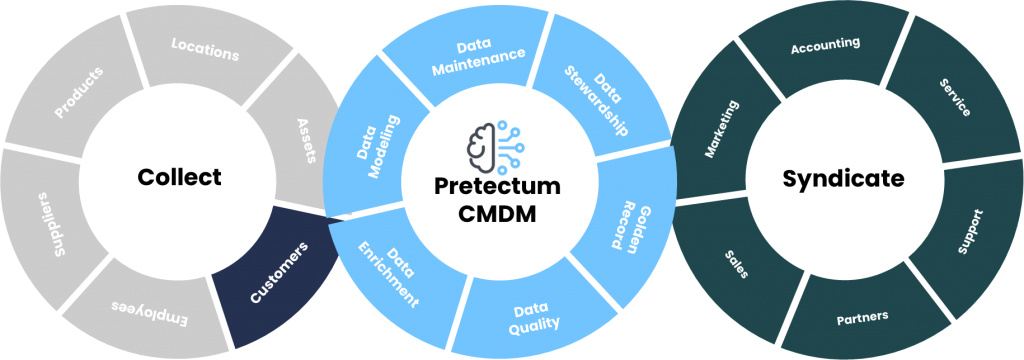Master Data Management (MDM) plays a pivotal role in ensuring the accuracy, consistency, and reliability of an organization’s critical data.
The choice between a general-purpose MDM and a Customer Master Data Management (CMDM) system can significantly impact the effectiveness of data management strategies. Here at Pretectum, we continuously emphasize why CMDM may offer distinct advantages over general-purpose MDM, particularly when it comes to handling customer data.
A matter of focus
Before delving into the advantages of CMDM, it’s crucial to comprehend the fundamental differences between general-purpose MDM and CMDM.
With general-purpose MDM the approach involves managing master data across various domains within an organization, such as products, employees, suppliers, and customers. While it provides a holistic view of data, it may lack the depth required to meet the specific needs of certain data domains.
CMDM, on the other hand, is a specialized subset of MDM that concentrates solely on customer data. This focused approach allows organizations to streamline their efforts in maintaining accurate and up-to-date information about their customers, enhancing customer relationship management (CRM) and overall business performance.

Complexity and Customization Challenges
One of the primary drawbacks of general-purpose MDM lies in its complexity and the challenges associated with customization. Managing multiple data domains requires intricate configurations, making it a time-consuming and resource-intensive process. In contrast, CMDM’s narrow focus allows for more straightforward implementations and customization tailored to the specific needs of customer data.
Resource Allocation and Maintenance Costs
Implementing and maintaining a general-purpose MDM system often demands substantial resources, both in terms of time and financial investment. Organizations may find themselves allocating resources across various domains, leading to increased complexity in implementation and ongoing maintenance. CMDM, being more specialized, can potentially reduce costs associated with resource allocation, as the focus is directed solely towards customer data.
Diluted Data Quality
A broad-spectrum MDM strategy can sometimes result in diluted efforts to maintain data quality. The broader the focus, the more challenging it becomes to enforce stringent data governance measures and controls. CMDM on the other hand, by concentrating on customer data exclusively, allows organizations to enforce higher standards of customer data quality, ensuring that information related to customers is consistently accurate and reliable.

Agility and Responsiveness
The ability to adapt quickly to changing customer needs and market trends is crucial these days. General-purpose MDM, with its broad scope, may struggle to provide the agility required to respond promptly to customer-centric demands. CMDM, by its singular focus on customer data, allows organizations to be more agile in tailoring their strategies to meet evolving customer expectations.
Enhancing the Customer Experience
CMDM excels in improving the overall customer experience by providing a single, comprehensive view of the customer’s data. This unified perspective enables organizations to gain insights into customer preferences, purchase history (if available), and interactions across various touchpoints (Pretectum supports a flexible data model).
Such insights empower businesses to personalize interactions, anticipate customer needs, and ultimately enhance customer satisfaction.
Streamlined Customer Relationship Management (CRM)
A CMDM system aligns seamlessly with CRM initiatives, creating a synergy that promotes more effective customer relationship management. By consolidating and synchronizing customer data, CMDM ensures that CRM systems have access to accurate and real-time information, facilitating more informed decision-making and fostering stronger customer relationships.
Compliance and Data Governance
CMDM facilitates more robust data governance practices, particularly concerning regulatory compliance. Obtain consent and handle zero, first, second, and third party data scenarios. With a singular focus on customer data, organizations can implement and enforce stringent data quality standards, ensuring compliance with data protection regulations. This specialized approach simplifies auditing processes and reduces the risk of non-compliance, thereby enhancing the organization’s reputation and trustworthiness.

Faster Time-to-Value
Implementing CMDM is often faster and more straightforward compared to general-purpose MDM. The narrower focus allows organizations to deploy CMDM solutions more quickly, realizing value sooner. This speed is particularly beneficial in dynamic industries where rapid adaptation to market changes is essential.
Improved Data Security
CMDM’s concentrated approach to customer data simplifies data security measures. Organizations can implement more robust security protocols tailored specifically to safeguarding customer information. This focused strategy reduces the risk of data breaches and unauthorized access, safeguarding sensitive customer data from potential threats.
While general-purpose MDM undoubtedly plays a vital role in managing various data domains within an organization, the advantages of Customer Master Data Management (CMDM) in handling customer data are hopefully quite evident.
CMDM’s focus on streamlining customer-related processes, enhancing customer experiences, and ensuring compliance makes it a compelling choice for organizations looking to derive maximum value from their data management initiatives.
Customer-centricity is paramount these days, and CMDM emerges as a strategic choice that aligns seamlessly with the goals of fostering strong, long-lasting customer relationships and driving business success.

